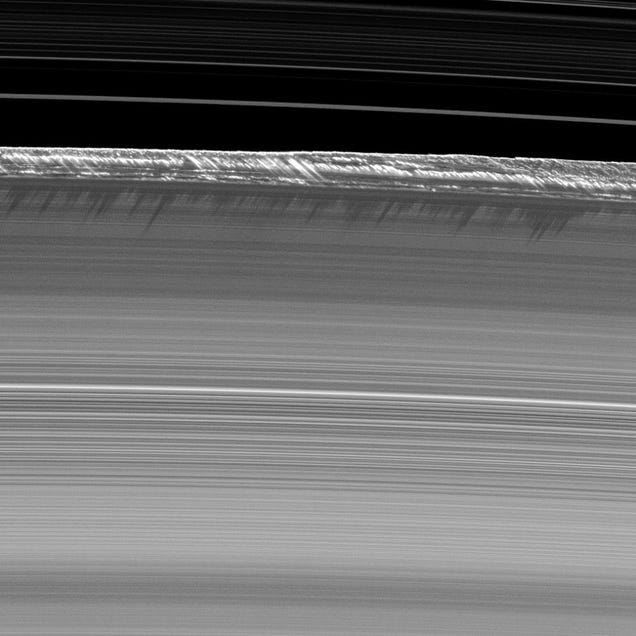
Someone on Reddit posted this old November 2010 image by the Cassini spacecraft. It shows 2-mile-high (3.5-kilometer) structures rising on Saturn's B ring's outer edge. We talked about this back then, but it's a great peg to show this cool artist impression of what it would look like from the ring itself:

Another finding from new images of the B ring's outer edge was the presence of at least two perturbed regions, including a long arc of narrow, shadow-casting peaks as high as 3.5 kilometers (2 miles) above the ring plane. The areas are likely populated with small moons that might have migrated across the outer part of the B ring in the past and got trapped in a zone affected by the moon Mimas' gravity. This process is commonly believed to have configured the present-day solar system.
This time-lapse video captured by Cassini gives you an idea of how the small moon's gravity affects the ring edge:
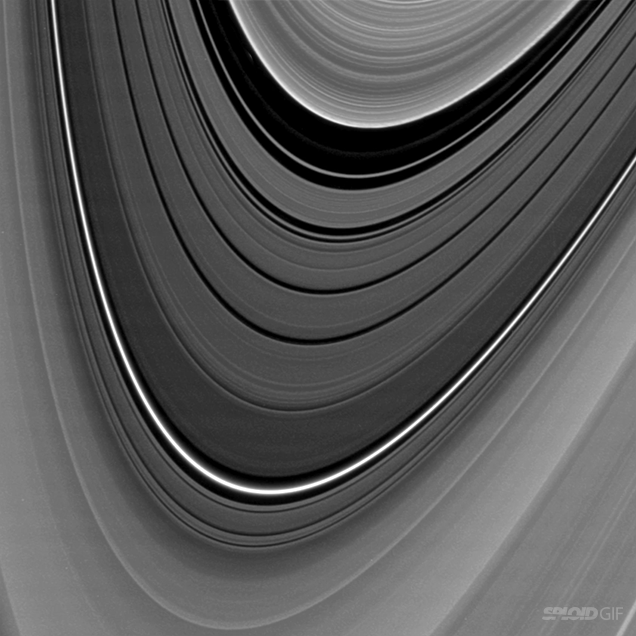
And since we are at it, enjoy the latest stunning images from Saturn from the Cassini spacecraft:

Saturn is circled by its rings (seen nearly edge-on in this image), as well as by the moons Tethys (the large bright body near the lower right hand corner of this image) and Mimas (seen as a slight crescent against Saturn's disk above the rings, at about 4 o'clock). The shadows of the rings, each ringlet delicately recorded across Saturn's face, also circle around Saturn's south pole.
Although the rings and larger moons of Saturn mostly orbit very near the planet's equatorial plane, this image shows that they do not all lie precisely in the orbital plane. Part of the reason that Mimas (246 miles, or 396 kilometers across) and Tethys (660 miles, or 1062 kilometers across) appear above and below the ring plane because their orbits are slightly inclined (about 1 to 1.5 degrees) relative to the rings.
This view looks toward the sunlit side of the rings from slightly above the ringplane. The image was taken in visible light with the Cassini spacecraft wide-angle camera on Aug. 14, 2014.
The view was obtained at a distance of approximately 1.1 million miles (1.7 million kilometers) from Saturn and at a Sun-Saturn-spacecraft, or phase, angle of 23 degrees. Image scale is 63 miles (102 kilometers) per pixel.
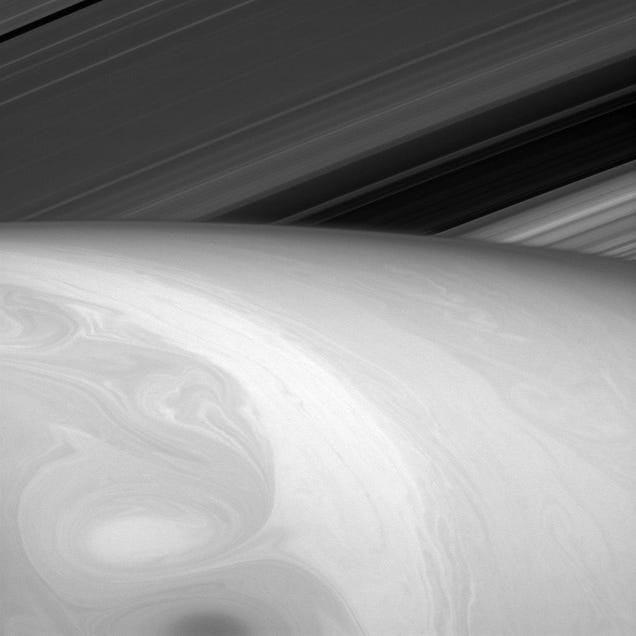
What the viewer might perceive to be Saturn's surface is really just the tops of its uppermost cloud layers. Everything we see is the result of fluid dynamics. Astronomers study Saturn's cloud dynamics in part to test and improve our understanding of fluid flows. Hopefully, what we learn will be useful for understanding our own atmosphere and that of other planetary bodies.
This view looks toward the sunlit side of the rings from about 25 degrees above the ringplane. The image was taken in red light with the Cassini spacecraft narrow-angle camera on Aug. 23, 2014.
The view was obtained at a distance of approximately 1.1 million miles (1.7 million kilometers) from Saturn and at a Sun-Saturn-spacecraft, or phase, angle of 23 degrees. Image scale is 63 miles (102 kilometers) per pixel.
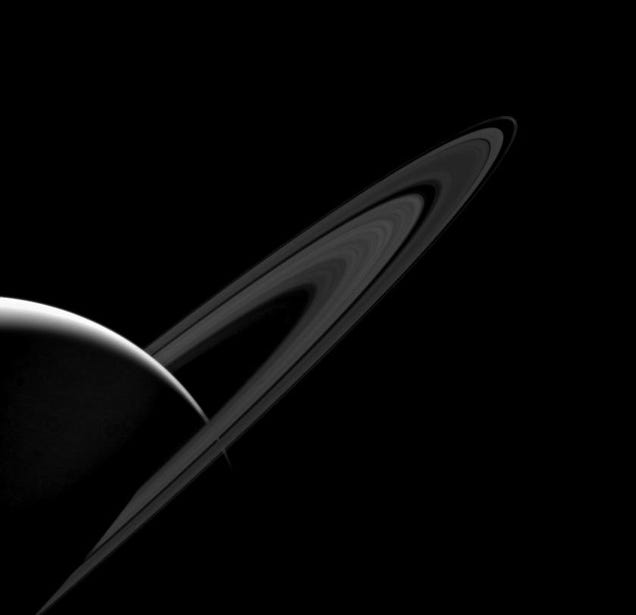
Saturn's main rings, seen here on their "lit" face, appear much darker than normal. That's because they tend to scatter light back toward its source — in this case, the Sun.
Usually, when taking images of the rings in geometries like this, exposures times are increased to make the rings more visible. Here, the requirement to not over-expose Saturn's lit crescent reveals just how dark the rings actually become. Scientists are interested in images in this sunward-facing ("high phase") geometry because the way that the rings scatter sunlight can tell us much about the ring particles' physical make-up.
This view looks toward the sunlit side of the rings from about 6 degrees above the ringplane. The image was taken in visible light with the Cassini spacecraft wide-angle camera on Jan. 12, 2014.
The view was acquired at a distance of approximately 1.4 million miles (2.3 million kilometers) from Saturn and at a Sun-Saturn-spacecraft, or phase, angle of 152 degrees. Image scale is 86 miles (138 kilometers) per pixel.
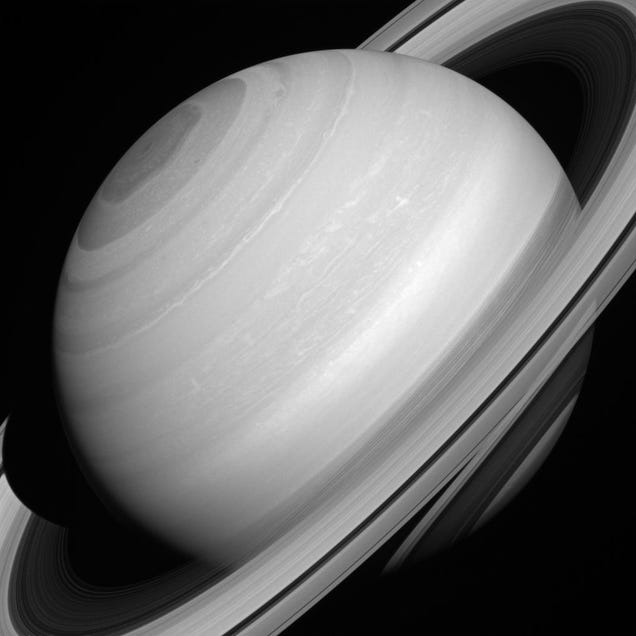
Although solid-looking in many images, Saturn's rings are actually translucent. In this picture, we can glimpse the shadow of the rings on the planet through (and below) the A and C rings themselves, towards the lower right hand corner.
For centuries people have studied Saturn's rings, but questions about the structure and composition of the rings lingered. It was only in 1857 when the physicist James Clerk Maxwell demonstrated that the rings must be composed of many small particles and not solid rings around the planet, and not until the 1970s that spectroscopic evidence definitively showed that the rings are composed mostly of water ice.
This view looks toward the sunlit side of the rings from about 17 degrees above the ringplane. The image was taken with the Cassini spacecraft wide-angle camera on Aug. 12, 2014 in near-infrared light centered at 752 nanometers.
The view was obtained at a distance of approximately 1.4 million miles (2.3 million kilometers) from Saturn and at a Sun-Saturn-spacecraft, or phase, angle of 24 degrees. Image scale is 85 miles (136 kilometers) per pixel.
I don't know about you, but all these photos taken by a camera 746 million miles (1.2 billion kilometers) away from us blow me away.
SPLOID is delicious brain candy. Follow us on Facebook or Twitter.
from Gizmodo http://sploid.gizmodo.com/two-mile-high-structures-rising-on-saturns-rings-1675970218
No comments:
Post a Comment